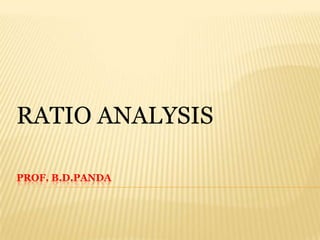
Ratio analysis techniques for financial assessment
- 2. RATIO ANALYSIS Ratio-analysis is a concept or technique which is as old as accounting concept. Financial analysis is a scientific tool. It has assumed important role as a tool for appraising the real worth of an enterprise, its performance during a period of time and its pit falls. Financial analysis is a vital apparatus for the interpretation of financial statements. It also helps to find out any cross-sectional and time series linkages between various ratios.
- 3. RATIO ANALYSIS Unlike in the past when security was considered to be sufficient consideration for banks and financial institutions to grant loans and advances, nowadays the entire lending is need- based and the emphasis is on the financial viability of a proposal and not only on security alone. Further all business decision contains an element of risk. The risk is more in the case of decisions relating to credits. Ratio analysis and other quantitative techniques facilitate assessment of this risk.
- 4. RATIO ANALYSIS Ratio-analysis means the process of computing, determining and presenting the relationship of related items and groups of items of the financial statements. They provide in a summarized and concise form of fairly good idea about the financial position of a unit. They are important tools for financial analysis.
- 5. RATIO ANALYSIS It’s a tool which enables the banker or lender to arrive at the following factors : Liquidity position Profitability Solvency Financial Stability Quality of the Management Safety & Security of the loans & advances to be or already been provided
- 6. CLASSIFICATIONS OF RATIOS Liquidity Ratio Solvency Ratio Activity Ratio Profitability Ratio
- 7. LIQUIDITY RATIO Current Ratio: It is defined as the relationship between the current assets and current liabilities. This ratio is also known as working capital ratio. Current Ratio = Current Assets/Current Liabilities The ideal Current Ratio preferred by Banks is 1.33 : 1 Quick ratio or Liquid ratio: It is the more rigorous test of liquidity than Current Ratio. Quick ratio is defined as the relationship between quick asset and current liability. Quick Ratio = Quick assets/ Current Liabilities The ideal quick ratio should be 1.
- 8. LIQUIDITY RATIO Absolutely Liquid Ratio: This ratio speaks about the relationship between the absolute liquid assets and current liability. Absolute liquid assets include Cash in hand, Cash at bank and marketable Securities or temporary investments. Absolute Liquid Ratio = Absolute liquid asset/Current Liability The acceptability norm for this ratio is 50% or 0.5:1.
- 9. SOLVENCY RATIO The term ‘solvency’ refers to the ability of a concern to meet its long term obligations. The following ratios serve the purpose of determining the solvency of the concern: Debt-Equity Ratio Proprietory Ratio Solvency Ratio Interest Coverage Ratio
- 10. SOLVENCY RATIOS Debt-Equity Ratio: This ratio is calculated to measure the relative claims of outsiders and the owners against the firm’s assets. This ratio indicates the relationship between the external debt and internal equities. Debt-Equity Ratio= Outsiders Funds/Shareholders fund The outsiders’ funds include all debts, liability to outsiders. Shareholders’ fund include equity capital, preference capital, capital reserve, revenue reserve, other reserve and surplus. A ratio of 1:1 may be usually considered as satisfactory or standard and sometimes 2:1 is also satisfactory.
- 11. SOLVENCY RATIOS Proprietory Ratio: This ratio establishes relationship between the shareholders’ funds to the total assets of the firm. The more the ratio, the more it is the better. Proprietory ratio = Shareholders' funds/Total assets Solvency Ratio: This ratio is a small variant of equity ratio and can be simply calculated 100- proprietory ratio. Solvency ratio = Total liabilities to outsiders/total assets
- 12. SOLVENCY RATIOS Interest Coverage ratio: Net income to debt service ratio is used to test the debt servicing capacity of a firm. The ratio is also called interest coverage ratio. This ratio is calculated by dividing the net profit before interest and taxes by fixed interest charges. Interest coverage ratio = EBIT/Fixed Interest charges Interest coverage ratio indicates that the number of times interest is covered by the profits available to pay the interest charges.
